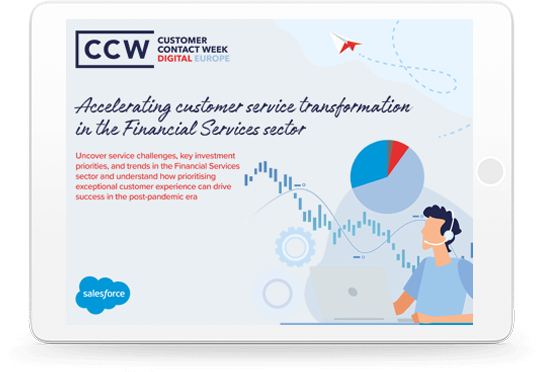Right now, customer service leaders working within Financial Services face four big challenges:
- Meeting customer expectations for highly personal, targeted and instant responses
- Embedding long-term hybrid working solutions
- Keeping ahead of sophisticated fraudsters that continue to test systems and processes
- Winning the hearts of customers over the competition (including neo banks, and super apps like Amazon)
In addition, as organisations seek to differentiate by upping the ante on customer care levels, service and technology leaders will be placed even closer to the centre of their companies’ growth strategies. Salesforce and Customer Contact Week Digital (CCW) recently spoke to Financial Services leaders and discovered that success, or failure, will hinge on how well they exploit omnichannel operations and the automation and AI that lies behind them.
This blog explores these challenges in more detail and features examples of leading Financial Services companies that have successfully implemented omnichannel operations in a matter of weeks.
Transforming Customer Service in Financial Services
Using insightful interviews with senior service leaders, discover how customer experience is driving post-pandemic success.

Customers want every channel they choose and complete understanding of their needs
When the world first entered lockdown back in March 2020, customers were generally supportive of companies as they rushed to put in place home working operations. Everyone understood why there were longer wait times and disjointed information.
Those times are over.
The Salesforce State of the Connected Customer report highlights a hardening of opinions. Customers increasingly insist on a seamless experience across all channels, with 66% saying they expect companies to understand their unique needs.
A customer may vary their channel choice – voice, video, chat, text, email, bot and more – over the lifetime of an engagement. But they will still expect a company to have a 360-degree view of them. Sometimes they will self-serve for simpler requests, like the status of a loan application or arranging an overdraft. Other times they will want expert, human interaction for something more complex, especially if it concerns important life moments.
It’s no surprise then, that 42% of customer care decision-makers told CCW that their top priority was omni-channel integration. These leaders clearly recognise the need for an infrastructure that delivers a frictionless customer experience across all current channels, plus the flexibility to add new channels over time.
Each team member needs a more diverse skill set
Financial Services companies, especially legacy banks, insurers and the like, are historically built on multi-channel services. Separate teams and systems, dealing with single product lines.
The result is a disconnected experience for the customer, who expects a complete view across all of their financial products, and a stressful experience for the agent, who is dealing with expectations they have not been equipped to service.
An omni-channel environment breaks the silos that multi-channels are built on, providing service teams what they need to deal with the dynamic nature of customer requests. Fungibility in a workforce – where teams share indistinguishable skills across multiple areas of the business – allows it to match the scale needed to operate effectively. In fact, the CCW report shows that 84% of service teams have shifted workflows and practices since the pandemic.
Scattered teams need consistent tools
In a recent survey from the CBI and PwC, 80% of UK Financial Services firms expect to take a hybrid approach to work.
Traditional contact centres are increasingly a thing of the past. Teams can be located at home, in branches and at HQs, supporting the delivery of 24/7 coverage. But, working from anywhere can throw up a number of challenges. Small laptops, patchy WiFi and distractions can make it difficult to deliver a great service, which is why teams need the tools to perform against any limitations.
A genuine omnichannel strategy enables leaders to manage those constraints and a dispersed resource centrally. Workloads can be monitored, queues can be re-routed and supervisors can contact agents during a customer call to give assistance.
Service teams are on the frontline fighting financial fraud on every channel
According to Reuters, the UK is the world’s epicentre of financial fraud. In the first six months of 2021 alone, £754m was stolen, an increase of 30% on the previous year. Per capita, the UK fraud rate is triple that seen in the US.
Service and technology leaders need to mitigate the risk of fraud in all customer interactions. Omni-channel environments are able to provide a whole picture of a customer’s history, with any potential discrepancies – around their identity, or whether they are being defrauded by a third party, for instance – quickly surfaced.
Salesforce omnichannel helps Financial Services leaders
As a company whose entire purpose is built upon providing an in-depth, joined-up customer view, Salesforce has built a unique omnichannel environment. All are managed through Salesforce Service Cloud Omni-Channel Supervisor, which delivers real-time information across every channel and all agents. Easy filtering allows leaders and their supervisors to see exactly how their people are dealing with requests, managing backlogged items, mitigating fraud and more.
In addition, Salesforce omni-channel environments are quick to implement.
In the space of five days, one of the world’s largest providers of life insurance, pensions and asset management had designed, tested and launched a Salesforce live chat channel to improve customer service. Within two weeks of going live, agents were handling 200 web chats a day across an advisor and customer base of around 400,000 people.
A Japanese financial group now sees 75% of its simple chats resolved by the Salesforce Einstein bot. A solution that took just one week to implement.
What does it all mean for service leaders in Financial Services?
Service leaders working within Financial Services face an increasingly complex environment. There are ever-higher customer expectations and a pandemic that continues to reshape working practices. Plus, a need for continued diligence when helping customers safeguard themselves from fraud and finding ways to compete with new entrants. Trailblazing leaders are harnessing the power of technology to deliver on those customer needs by empowering their teams with the tools and training they need to be at their best, in every single interaction.
Would you like to go deeper on this topic?
The traditional multi-channel approach has reached the end of its useful life span, and that’s reflected in the conversations that CCW had with 45 senior customer experience and customer service leaders within the Financial Services industry. Read more about their findings in the Transform Customer Service in Financial Services Report.
The next blog in this series aimed at Financial Service leaders discusses how Artificial Intelligence is empowering customer service teams and their leaders to deliver outstanding customer service on all channels at all times.
Transforming Customer Service in Financial Services
Using insightful interviews with senior service leaders, discover how customer experience is driving post-pandemic success.

























